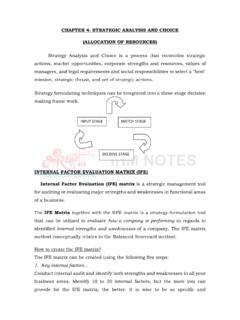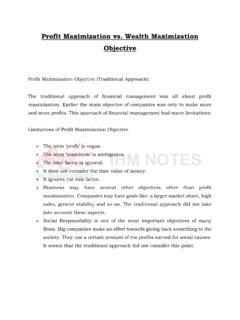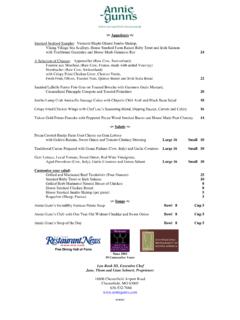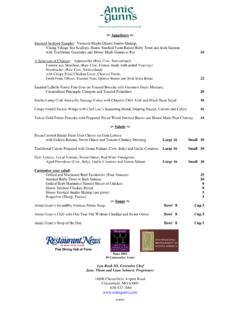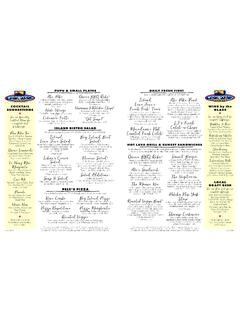Transcription of Food and Beverage Service - IHM Notes
1 PrincipalState Institute of Hotel Management & Catering TechnologyThuvakkudi, TiruchirappalliFood and 120/05/16 10:24 AMFood and Beverage ServiceSECOND EDITIONO xford University Press Oxford University Press. All rights University Press is a department of the University of furthers the University s objective of excellence in research, scholarship, and education by publishing worldwide. Oxford is a registered trade mark of Oxford University Press in the UK and in certain other in India by Oxford University PressYMCA Library Building, 1 Jai Singh Road, New Delhi 110001, India Oxford University Press 2011, 2016 The moral rights of the author/s have been edition published in 2011 Second edition published in 2016 All rights reserved. No part of this publication may be reproduced, stored in a retrieval system, or transmitted, in any form or by any means, without the prior permission in writing of Oxford University Press, or as expressly permitted by law, by licence, or under terms agreed with the appropriate reprographics rights organization.
2 Enquiries concerning reproduction outside the scope of the above should be sent to the Rights Department, Oxford University Press, at the address must not circulate this work in any other form and you must impose this same condition on any : 978-0-19-946468-5 ISBN-10: 0-19-946468-5 Typeset in GaramondPro-Regularby Ideal Publishing Solutions, DelhiPrinted in India by Magic International (P) Ltd., Greater NoidaCover image: Yeko Photo Studio / ShutterstockThird-party website addresses mentioned in this book are providedby Oxford University Press in good faith and for information University Press disclaims any responsibility for the material contained and 220/05/16 10:24 AMOxford University Press Oxford University Press. All rights the years, the lifestyle of people has changed resulting in an increased number of commercial food Service outlets, contract catering, institutional catering, transport catering, food retails, and hotels.
3 All these establishments are in need of well informed and thoroughly trained food Service professionals to extend quality services to their guests. In today s competitive business environment, quality of services makes a huge difference and remains a USP is heartening to note that the first edition of the book has been well-received by faculty members, students, and practising managers. Hence, the second edition of the title food and Beverage Service has been extensively revised and updated keeping in view the feedback received, the National Council for Hotel Management and Catering Technology syllabi, as well as the ever-dynamic hospitality industry. Therefore, the text includes new chapters on menu knowledge; costs, sales, and profit; and food cost controls.
4 Sections on pairing wine with Asian food , and EU regulations and labelling laws have also been covered keeping in mind the needs of not only students, but practitioners. NEW TO THIS EDITION New chapters on menu Knowledge; Costs, Sales, and Profit; and food Cost Control New sections on EU wine regulations and labelling laws, and pairing wine with Asian food Augmented web resources for both teachers and students CONTENTS AND COVERAGE The book has 51 chapters that have been divided into six I: Introduction to food and Beverage Service Chapter 1 provides an introduction to the food Service industry in India, along with the employment opportunities it provides. Chapter 2 discusses the various functions of food and Beverage staff of hotel, and the intra- and inter-department relationships. Different types of food Service equipment as well as ways to properly store them have been mentioned in Chapter 3.
5 Chapter 4 explains the functions of various ancillary sections such as still room, silver room, linen store, various styles of food Service waiter Service , self- Service , and assisted Service have been discussed in Chapter 5. Part II: menu Knowledge and Planning The origin and types of menu are explained in Chapter 6. PREFACE TO THE SECOND EDITIONFood and 520/05/16 10:24 AMOxford University Press Oxford University Press. All rights to the Second EditionChapter 7 gives detailed knowledge about compound butters, sauces, and the French classical course. Chapter 8 discusses the cover and accompaniments for selected Continental and Indian dishes. Chapter 9 explains the various French and culinary terms used in F&B Service . The process of planning various types of menus have been dealt with in Chapter 10. Part III: food Service Chapter 11 discusses the activities to be carried out before and after the Service , whereas Chapter 12 explains the Service procedure for la carte lunch or dinner and table d h te menu .
6 Chapters 13 and 14 elaborate on the types of menus, covers, and Service procedures associated with breakfast, and brunch and afternoon tea, respectively. The entire process of room Service , from location and equipment required to taking orders and execution to in-room facilities, have been dealt with in Chapter 15. Chapter 16 explains gu ridon Service , including the types of trolley, equipment used, food preparation techniques, and dishes prepared on the trolley. Order taking and billing methods are discussed in Chapter 17. Chapter 18 focuses on handling different situations and guests in the dining areas. Part IV: Beverages and Tobacco Chapter 19 discusses various non-alcoholic beverages such as coffee, tea, milk-based drinks, juices, etc., whereas Chapter 20 deals with alcoholic beverages, their classification, and methods of preparation.
7 Chapter 21 provides an introduction to wine , its classification, characteristics, factors that influence its character, and grape varieties used. The process of winemaking still and sparkling is covered in Chapter 22. Chapters 23 and 24 deal with fortified wines such as Sherry and Madeira, and vermouth and bitters, respectively. Wines of France, their classification, regions, and laws have been included in Chapter 25. Wines of Italy, Germany, Spain, and Portugal are discussed in Chapters 26, 27, and 28. Chapter 29 focuses on the wines of various other countries such as the USA, Australia, South Africa, Hungary, and India. Chapter 30 explains the rules for pairing wine with food and problem dishes. The special focus is on pairing Asian food with the right wine . Chapter 31 deals with beer, its production, strength, and storage.
8 Major spirits such as cider, perry, whisky, brandy, gin, rum, vodka, tequila, and mescal are covered in Chapters 32 39. Liqueurs and eaux-de-vie are explained in Chapter 40. The Service of alcoholic beverages, such as wines, beer, spirits, liqueurs, and cocktails are discussed in Chapter 41. Chapter 42 provides information about components of cocktails, the methods, equipment, and glassware used, and rules to follow when making cocktails and mixed drinks. This chapter also discusses hot drinks and mocktails. Chapter 43 elaborates on cigar, its structure, brands, and Service . Service of cigarettes is also included in this V: Bar Operations and Control Chapter 44 discusses the function of cellar, location, and storage, as well as cellar control and records. Bar operations, such as types of bars, their design, records and control, and operations procedures have been dealt with in Chapter 45.
9 Part VI: Ancillary Functions Chapter 46 covers topics such as types of function, duties, and responsibilities of function staff, table arrangements, function menus, buffet set-up, and Service procedure for formal functions. food and 620/05/16 10:24 AMOxford University Press Oxford University Press. All rights Preface to the Second EditionSupervisory functions in food Service operations, such as briefing, allocation of tables, stock taking, and cost analysis, are discussed in Chapter 47. Chapter 48 explains the different types of costs involved in food and Beverage Service operations, whereas the process of monitoring and regulating the food cost is covered in Chapter 49. Chapter 50 discusses the importance of customer relations management in F&B Service industry. Chapter 51 provides information about the safety measures to be taken while handling and storing food products.
10 ONLINE RESOURCES The following resources are available to support the faculty and students using this FacultyFor Students PowerPoint presentations Multiple-choice questions Flashcard glossaryACKNOWLEDGEMENTS I would like to express sincere gratitude to many of my friends and colleagues from the hospitality industry and the academia who assisted me in many ways in the writing of this book. Though I would like to name them all, it is practically not possible to do so. I would particularly like to thank the following persons:Mr Keerthivasan, General Manager, Ambasador Pallava, ChennaiMr K. Venkataraju, Executive Assistant Manager, Hotel Ambassador Pallava, Chennai Mr Balraja, Principal, Sterling Holiday Resorts, KodaikanalMr Subramanian, General Manager, Heritage Inn, CoimbatoreMr K. Ramachandran, General Manager, Heritage Inn, Coimbatore Mr Sonu Koithara, Executive Chef, Taj Kovalam, Kovalam, TrivandrumMr Ashok, Executive Chef, The Residency, CoimbatoreMr Samuel David, Chief Engineer, Taj Kovalam, Kovalam, Trivandrum Mr Santhavadanam, Executive House Keeper, Hotel Savera, ChennaiMr Babu Varma, Senior Manager Projects ( food services ), Sodexo food , Facilities and Project ManagementI also thank my teacher and mentor Mr A.




